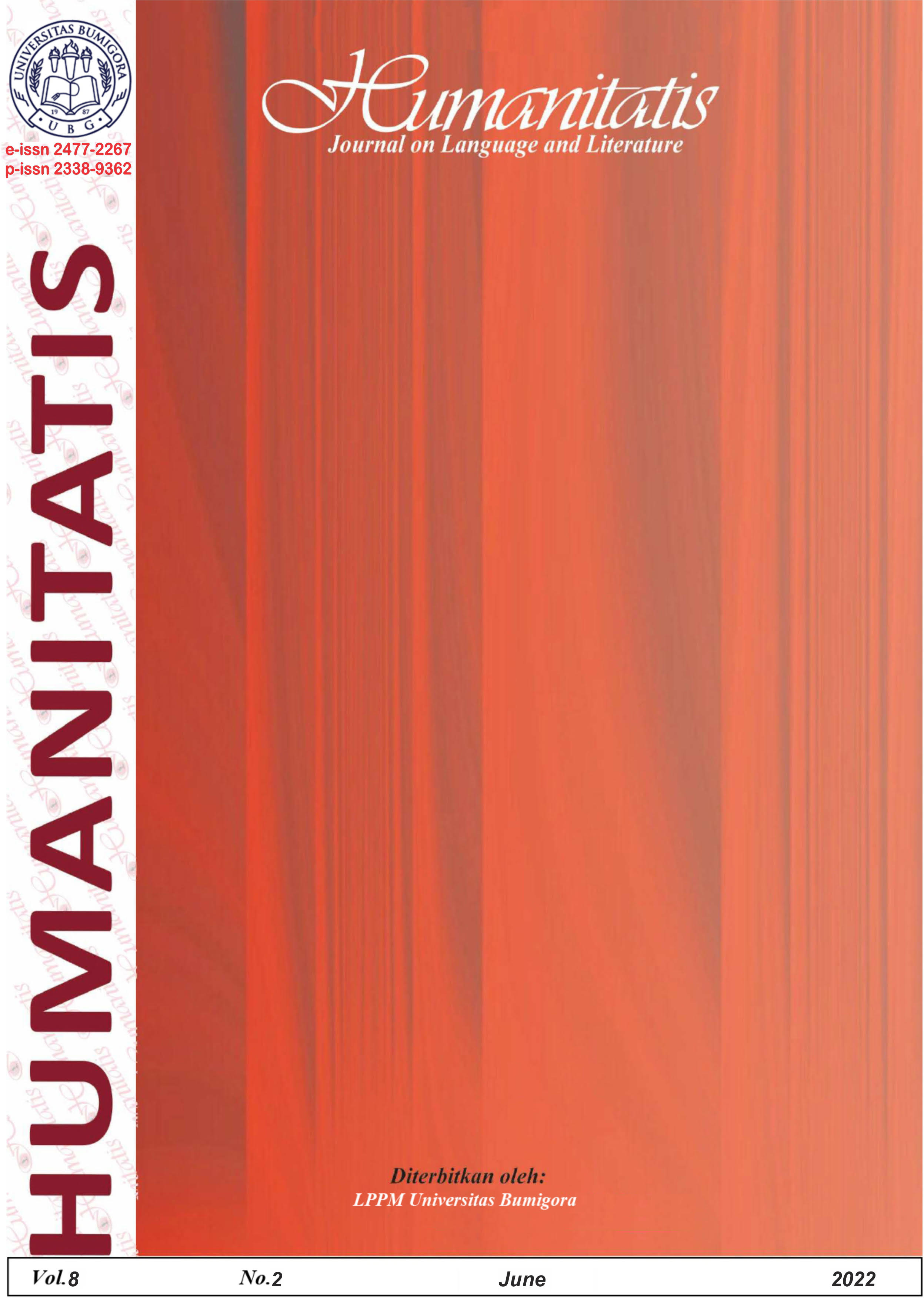The Representation of Identity Crisis in Minari: A Critical Discourse Analysis
DOI:
https://doi.org/10.30812/humanitatis.v8i2.1893Keywords:
diaspora, identity crisis, critical discourse analysis, psychology perspectivesAbstract
This study examines the representation of identity crisis in Minari, an American film depicting the life of Korean diasporas in the USA. This study employed Critical Discourse Analysis to analyze the identity crisis encountered by the main character and Korean and western cultural contact in the United States of America. The researchers analyzed the main protagonist using psychological perspectives to uncover unconsciousness in his decision-making to obtain the study's objectives. In this study, the main character of this film was Jacob, after undergoing the three stages of Greimas’ structural analysis. The main character displayed an identity crisis in discursive actions, non-discursive, and discourse materialization. Further analysis uncovered that immigration was the basis for the identity crisis in Minari. Moreover, the identity crisis was described in Jacob's roles in the diaspora process: the first child, husband, and father. Of the three roles, the circumstances experienced in the diaspora process made Jacob struggle with his identity. Fortunately, he overcame the identity crisis, which was symbolized by minari, a vegetable, as a symbol of perseverance in the film.
References
Bilal, H. A., Zaman, K., Azhar, P., Zaman, K. M., Pervaiz, A., & Hayat, K. (2021). Portrayal Of Pakistan On The Silver Screen: A Critical Discourse Analysis. In PSYCHOLOGY AND EDUCATION (Vol. 58, Issue 5). https://www.researchgate.net/profile/Hafiz-Bilal-3/publication/351775133_Portrayal_Of_Pakistan_On_The_Silver_Screen_A_Critical_Discourse_Analysis/links/60a8d79ca6fdcc6d6266e140/Portrayal-Of-Pakistan-On-The-Silver-Screen-A-Critical-Discourse-Analysis.pdf
Cresswell, L., & Cage, E. (2019). ‘Who Am I?’: An Exploratory Study of the Relationships Between Identity, Acculturation and Mental Health in Autistic Adolescents. Journal of Autism and Developmental Disorders, 49(7), 2901–2912. https://doi.org/10.1007/s10803-019-04016-x
Haboush, J. K. (2014). The Confucianization of Korean society. In The East Asian Region (pp. 84–110). Princeton University Press. https://doi.org/10.1515/9781400861934.84
Jäger, S. (2013). Discourse and Knowledge: Theoretical and Methodological Aspects of A Critical Discourse and Dispositive Analysis. In Methods of Critical Discourse Analysis (pp. 32–62). SAGE Publications, Ltd. https://doi.org/10.4135/9780857028020.n3
Jensen, S. H. (1978). Language learning in the wild: A young user perspective Introduction and Aims. Language Learning & Technology, 23(1), 72.
Jӓger, S., & Maier, F. (2009). Theoretical and Methodological Aspects of Foucauldian CDA and Dispositive Analysis. In Wodak (Ed.), Method of Critical Discourse Analysis (pp. 34–61). SAGE.
Kang, Y. (1979). Any One Parent Will Do: Negotiations of Fatherhood among South Korean “Wild Geese†Fathers in Singapore. In Source: The Journal of Korean Studies (Vol. 17, Issue 2). https://www.jstor.org/stable/23622303
Lee, K. K. (1998). Confucian tradition in the contemporary Korean family. In Slote (Ed.), Confucianism and the Family: A Study of Indo-Tibetan Scholasticism (pp. 249–266). State University of New York.
Lee, Y. J., & Moon, S. G. (2011). Mainstream and Ethnic Volunteering by Korean Immigrants in the United States. Voluntas, 22(4), 811–830. https://doi.org/10.1007/s11266-010-9176-y
Lundström, M., & Lundström, T. P. (2020). Podcast Ethnography. International Journal of Social Research Methodology, 1–11. https://doi.org/10.1080/13645579.2020.1778221
Min, P. G. (2011a). Koreans’ immigration to the US: History and contemporary trends. New York: The Research center for Korean community Queens College of CUNY.
Min, P. G. (2011b). The Immigration of Koreans to the United States: A Review of 45 Year (1965-2009) Trends. In DEVELOPMENT AND SOCIETY (Vol. 40, Issue 2).
Montes R. C. P. (2020). “El Infiernoâ€: A Critical Discourse Analysis of Narco Culture in a Mexican Film. Open Journal for Studies in Arts, 3(2), 53–64. https://doi.org/10.32591/coas.ojsa.0302.02053r
Sari, K., & Pranoto, B. E. (2021). Representation of Government Concerning the Draft of Criminal Code in The Jakarta Post: A Critical Discourse Analysis. Parole: Journal of Linguistics and Education, 11(2), 98–113. https://doi.org/https://doi.org/10.14710/parole.v11i2.98-113
Schoor, C. (2021). Probing into Populism’s Core: An Analysis of the Deep Semio-linguistic Structure Underlying Populism. Critical Discourse Studies, 18(2), 226–244. https://doi.org/10.1080/17405904.2020.1769698
Seok, J. O., & Chung, J. K. (2021). The Movie Minari Seen Through Coaching Psychology (Issue 4). www.psychologyandeducation.net
Shah, M. I., Ahmad, S. A., & Danishs, A. (2021). Controversies in Political Ideologies: A Critical Discourse Analysis of Speeches of Indian and Pakistani Premiers on Pulwama Incident. Register Journal, 14(1), 43–64. https://doi.org/10.18326/rgt.v14i1.43-64
Sitepu, I. V. R. (2017). Studying Multicultularism through Readings of Diasporic Writing: Indonesian Way of Learning Differences and Diversity. 45–49. http://repository.uki.ac.id/1818/
Tiruneh, D., Baye, G., & Dubi, Y. B. (2020). A Critical Discourse Analysis of COVID-19 in Ethiopia: Rethinking the Past and Defining the Present. Journal of Language and Literature, 20(2), 318. https://doi.org/10.24071/joll.v20i2.2608
Tusita, A. (2017). Negotiation Done by Alim in Defining His Cultural Identity in The Movie Touch of Pink. 25–28. http://repository.unas.ac.id/1624/1/Proceedings-LSC-5-Final1.pdf#page=26
van Leeuwen, T. (2008). Discourse and Practice. New Tools for Critical Discourse Analysis. Oxford University Press.
Yoon, I. J. (2012). Migration and the Korean Diaspora: A Comparative Description of Five Cases. Journal of Ethnic and Migration Studies, 38(3), 413–435. https://doi.org/10.1080/1369183X.2012.658545












